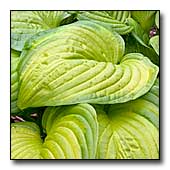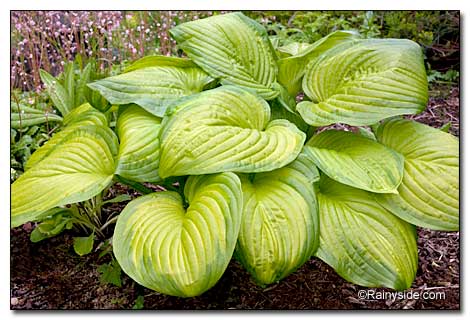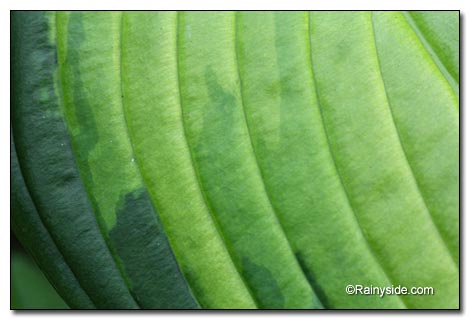Hosta 'Stained Glass'
PLANTAIN LILY
Family: Asparagaceae
Pronounced: HOSS-tuh

Quick Jumps
Growing Guide
Rainy Side Notes
GROWING GUIDE

Origin:
Garden.
Plant group:
Perennials
Hardiness:
Sunset zones: 1-10,14-21.
USDA zones: 3-9.
Heat zones: 9-2.
Mature size:
Height: 20 inches (60 cm).
Width: 4 feet (1.2 m).
Flowering period:
Summer.
Flowering attributes:
One sided racemes of fragrant, pale lavender to almost white, tubular flowers.
Leaf attributes:
Bright yellow leaves, with dark green margins.
Growth habit:
Clumping.
Light:
Partial sun (morning sun) to shade.
Soil:
Fertile, moist, humus rich, well-drained soil.
Feeding:
Hostas are heavy feeders, so fertilize monthly with a complete organic fertilizer, from spring through July.
Propagation methods:
Divide Hostas in early spring and late summer.
Pests and Diseases:
Slugs, foliar nematodes, and vine weevils can be problems.
Rainy Side Notes

I remember when Hostas were called Funkias. How strange it is to think back to that time when I had very little knowledge of them and didn't appreciate plants without big, bright, or blousy blossoms. As many gardeners do after gardening awhile, I began to appreciate foliage and textures. Although I still swoon over flowers, they are not the essential element of my garden beds anymore. If something isn't in bloom, the foliage carries the garden through the ebb and flow of the flower show. Hosta 'Stained Glass' has large, fragrant, almost-white flowers, but I grow it for its wonderful foliage.
Granted, I like Hostas, but I am not smitten like some of my favorite gardeners are. Some are so enamored that their gardens are covered in them. I prefer to grow these perennials in with other plants, threading smaller leaved textures around them or placing them as foliage accents in containers. I have one bed where I grow Saxifraga 'London's Pride' close by, threatening variegation buildup in the garden; yet somehow it works.
A Hans Hansen introduction in 1999, Hosta 'Stained Glass' is a tissue-cultured sport of H. 'Guacamole'. Named Hosta of the Year in 2006, the plant is noted for its bright yellow leaves with green margins that deepen a little with more contrast as the leaves age. My plant tends to be more chartreuse than yellow, but it gets no direct sun at all after the plum tree above it leafs out. Since it’s reported to be a sun-tolerant Hosta, I am dividing and moving a piece of it out into a sunny position and another to a morning sun/afternoon shade location, to compare how it will grow differently than it does in the shade.
Slugs are a big pest for Hostas—riddling holes in the leaves. The damage these mollusks do to the plant nullifies the main reason to grow them—fantastic foliage. However, 'Stained Glass' is supposed to be slug resistant. In spite of that fact, I still find holes in the leaves.
One slug abatement experiment I tried was sprinkling already brewed coffee grounds around its base. The year I did this, the Hosta's leaves were left untouched. I only found one bite that year. The following year, the slug damage was present, because I failed to put coffee grounds down. The fresh brewed grounds, worked as a slug deterrent. The results of my experiment were very encouraging; however, I want to repeat it to make sure my results weren't just a fluke.
Photographed in author's garden.

Gardening for the Homebrewer: Grow and Process Plants for Making Beer, Wine, Gruit, Cider, Perry, and More
By co-authors Debbie Teashon (Rainy Side Gardeners) and Wendy Tweton
Copyright Notice | Home | Search | Perennials

